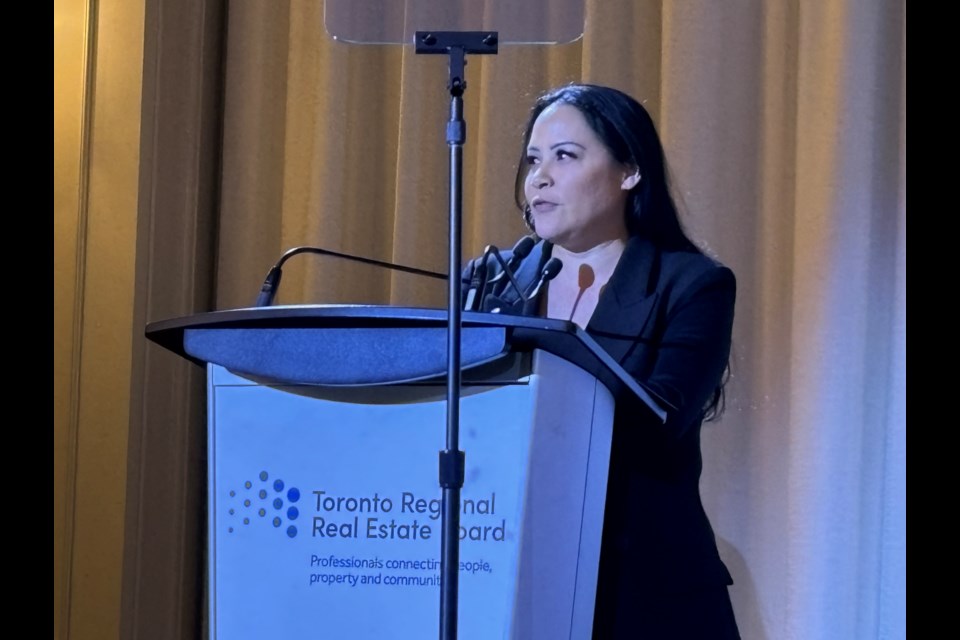A vibrant community like Newmarket could be a hub for more residents but the current price of homes is a disadvantage, highlighting the need for more "middle housing," according to the Toronto Regional Real Estate Board.
“The population of the GTA is steadily on the rise,” said TRREB president Jennifer Pearce at an market outlook and year in review in Vaughan on March 21. “To build a balanced market with more attainable homes, prioritizing missing middle housing will provide more diverse and affordable housing options. This will enable builders to create multi-family housing units and purpose-built rentals that can be scaled up much faster than one-off development proposals.”
John DiMichele, chief executive officer at TRREB, would also like to see more mixed homes, smaller modular homes, and micro homes so that people can live and stay in the communities they were raised in, as the federal government aims to welcome 485,000 new permanent residents in 2024, 500,000 in 2025 and another 500,000 in 2026.
“You want to stay in the same community,” said DiMichele. "Give people the opportunity to stay where they grew up or where they live, where their friends and family are, where they shop. We need that, but what we’re seeing with the influx of people is the pressure has become more.”
Governments need to step in and help first-time home buyers as young people are going to have a hard time getting into the market, he added. Better programs and incentives are required.
“Young people today trying to pay these prices, there’s a huge amount of insecurity,” said DiMichele. “Unless you go to the bank of mom and dad, as they say, it creates a different problem. Now I have to borrow money from my house, for my kid to have a downpayment, so now effectively you have two mortgages instead of just one.”
TRREB commissioned Ipsos to survey people and their home-buying intentions. Their results suggest that the share of likely homebuyers for this year remained the same as last year at 28 per cent. However, the share of people who said they were very likely to purchase dipped two percentage points to nine per cent.
Sales, prices and new listings results in 2023 showed decreases when compared to 2022, according to the report. New listings in 2023 were down 8.6 per cent to 142,233.
In York Region, there were 11,919 sales in 2023 compared to 12,844 the year before.
The board found housing unaffordability in the Greater Toronto Area (GTA) is a significant concern with one of the highest rates in Canada.
A household is deemed to be living unaffordably if it spends more than 30 per cent of its income on housing. It states this applies to 29 per cent of all households in the GTA and 23 per cent of residents. Among these households, 59 per cent allocate between 30 to 50 per cent of their income to housing, while 41 per cent spend 50 per cent or more.
When compared to those in affordable housing who average a well-being score of 7.48 out of 10, residents spending 30 to 50 per cent of their income on housing reported an average well-being score of 6.97. Those spending 50 per cent or more of their income on housing experienced a more significant drop, with an average well-being score of 6.79.
The board states more immigration can bring significant benefits, but government policies must include a plan to ensure that newcomers have places to live that are affordable.
With more skilled immigrants moving to the country to fill job vacancies and promote economic growth, lack of housing and unaffordability has caused undue pressure on the physical and mental health of residents.
“Of course, we need immigration of course, we need that for the economy,” said DiMichele. “We welcome everybody with open arms, but we have to pay attention to what we’re doing because more tent cities are popping up. You can see these things for yourself and you see it on these streets every day.”
The board states all three levels of government to their credit have continued to acknowledge the housing supply crisis and have introduced various policy initiatives to try and bring more housing online.
However, the housing supply does not just come from new construction. New listings of existing homes have flatlined over the past decade. In 2023, new listings were down substantially compared to already low levels in 2022.



